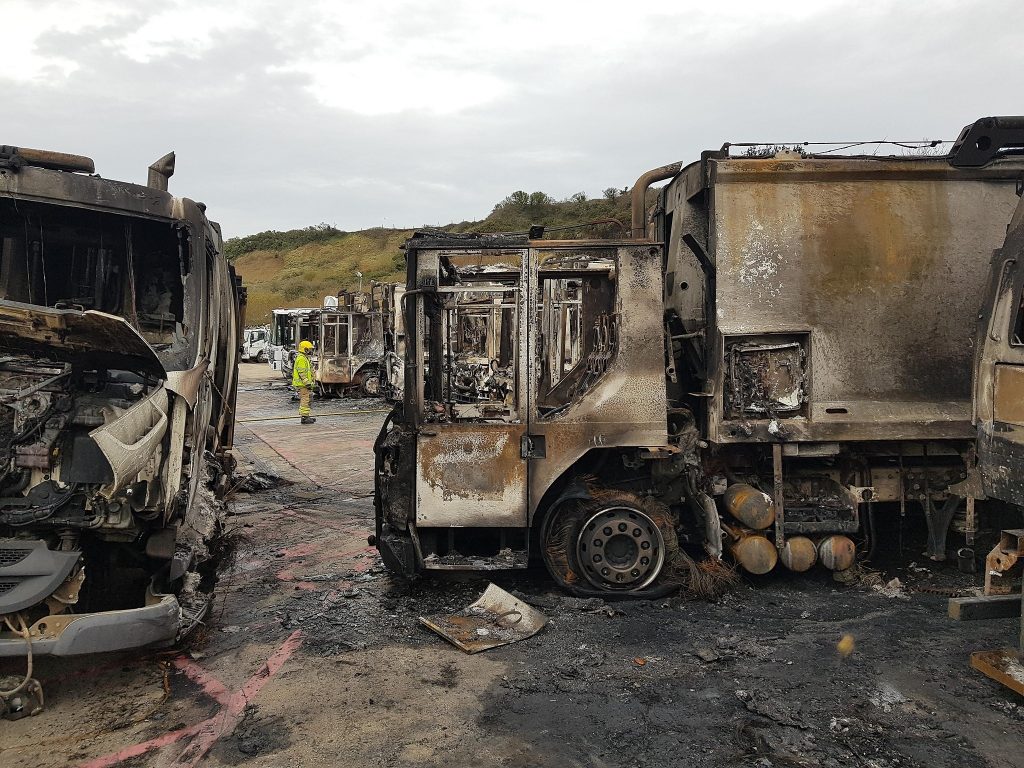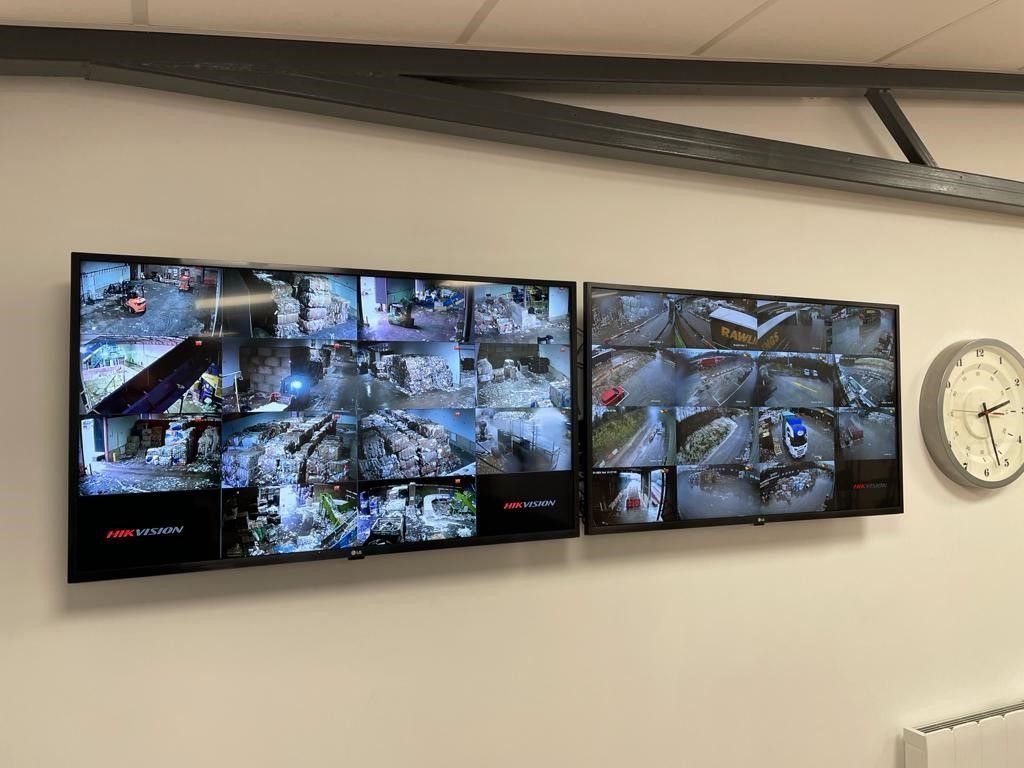Have you heard about zombie batteries? An article in the BBC [1] explains more about exploding batteries that ‘came back to life’ and caused an explosion and subsequent fire in a recycling centre. The operations manager recalls how the facility lost control of where the fire had even begun. Smoke was billowing from the machinery, described as “catastrophic, as burning plastic, paper and cardboard were about to quickly spread via conveyor belts which connect all of the facilities machinery.” The Fire Services and staff had to work frantically to remove metal panels to trace the ignition source.
Another blaze at a Dorset Council waste depot wiped out 21 vehicles used for rubbish collection, cleansing and maintenance with £3 million estimated in damages. Plus, disruption to 3 days of collections, catching up and cost in time of the site clean-up. Local residents were advised to keep indoors, and we see similar incidents in the length and breadth of the UK’s waste and recycling facilities. Refuse fires that have burned for days, cases of tyre recycling facilities dealing with an explosion – thankfully, a large percentage of these emergencies did not result in danger to human life. Between April 2019 and March 2020 alone, there were nearly 260 fires started by zombie batteries’ in recycling or waste management facilities.[2]

Quite often, what is the main culprit for such fire incidents? Incorrectly disposed of lithium-ion or alkaline and nickel batteries, that when punctured or impacted often result in an explosion of varying size. They are in many consumer devices that should be recycled separately but end up in the wrong disposal areas, or people mix batteries with their rubbish.
New research by Eunomia has even shown that “48% of annual waste fires are estimated to be caused by lithium-ion (Li-ion) batteries, costing the UK economy at least £158 million every year.”[3]
Consumers don’t always realise their potential damage and the ‘Take Charge’ campaign has been introduced by the Environmental Services Association to try and educate the public. A puncture or serious impact to these batteries will often result in an explosion of varying size and when that’s mixed with refuse and recycling materials, it makes these sites vulnerable.
As the serious fire incidents we’ve mentioned show, the knock-on effects go beyond fire damage and the associated clean-up operation. Business disruption, downtime, and complex and length insurance claims with excesses to pay out are a nightmare for any business. That’s why the earliest possible detection of a heat source above a ‘trigger’ temperature is crucial to minimise damage and risk. The latest fire technology reassures insurers about the safety measures in place for a high-risk building.
Many waste and recycling facilities across the UK have basic fire protection and alert systems fitted. But the worrying trend is that the alarm is often raised too late to prevent catastrophic damage and the growth of the fire. The incident numbers have stayed the same for over a decade, as the tools to combat and mitigate these fires more effectively have simply not been available.
As a company that works closely with the waste and recycling industry, we wanted to see how fire detection technology can be improved to reduce the risk of a serious fire incident. Types of automated systems include smoke and heat detectors with temperature probes, CCTV visual flame detection systems or spark, infrared and ultraviolet detectors.
So what fire protection is the best option for the waste and recycling industry?
Section 13 of the Environment Agency’s Fire prevention plans (2018) states: “You must have procedures in place to detect a fire in its early stages so you can reduce its impact. Your detection system should be proportionate to the nature and scale of waste management activities you carry out and the associated risks.”
CCTV visual flame detection gives the quickest early detection of a temperature increase – even before a confirmed fire has begun. There is no way for dust, dirt, fumes or moisture to send an inaccurate reading and it gives real-time visual confirmation and warning.
FLAMESCAN is the next-generation system for protecting industrial facilities that are at risk of fire. It uses both infrared and visual feeds to detect fire almost immediately, at distances up to 180m away. Immediate notification of fire to staff on-site, responders off-site and the Fire and Rescue services means the quickest way to locate and contain a fire. It integrates seamlessly into any existing fire alarm and/or CCTV systems or can be standalone.

Cost-effective, simple to use, and with proven reliability – the FLAMESCAN FCam series helps to limit your business’s exposure to the damaging effects fire can bring. Helios project managers will visit your site and conduct a survey, free of charge, providing a detailed design for your site using state-of-the-art 3D CAD modelling software to ensure all angles are covered.
Garry Adey, Managing Director at Helios adds:
“Here at Helios, we want to remain at the forefront of fire protection technology, so we vigorously research and test the equipment we produce and install. Thanks to significant investment and co-development of the latest technologies, when we talk with waste industry operators, we want to understand their operational issues and tailor our applications specifically to them. That way, they can focus on their core activity of recycling!
We work with your existing fire/security/ CCTV installer, or we can recommend an approved local installer. We support them with training if required, and we commission the finished system. Once tested by us, we then provide full certification to BS5839-1 for the design and commissioning of the system.”
Richard Hewitson, Director at Helios also hints at upcoming Research & Development:
“We are working very closely with two partner educational and research institutions on a ground-breaking system that detects both Alkaline and Lithium-ion batteries within a waste stream. We’re looking forward to sharing more about this revolutionary system that will prevent the need for manual removal and reduce the risk of explosions from incorrectly sorted electrical waste.”
Contact the team at Helios today, to find out how we can fully integrate and manage your fire protection needs via sales@heliosfiresystems.uk or by calling 0161 503 1626.
[1] https://www.bbc.co.uk/news/business-54634802
[2] https://www.takecharge.org.uk/
[3] https://resource.co/article/lithium-ion-battery-fires-costing-uk-economy-158-million-annually